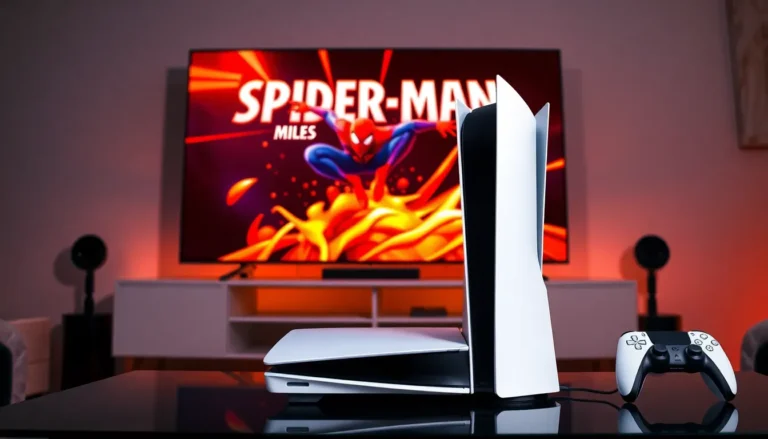In 2006, the gaming world was flipped on its head when Nintendo unleashed the Wii, a console that made couch potatoes leap off their sofas and into a virtual world of fun. Forget about sitting still; this innovative system turned gaming into a full-body workout, proving that you could indeed break a sweat while mastering your bowling skills.
With its quirky design and motion-sensing controls, the Wii captured hearts and living rooms alike, inviting everyone—from toddlers to grandparents—to join in on the action. It wasn’t just a console; it was a social phenomenon that brought families together and turned game nights into laugh-filled marathons. Dive into the story of the Wii’s release and discover how it revolutionized gaming, one swing at a time.
Table of Contents
ToggleOverview Of Nintendo Wii Release
Nintendo launched the Wii on November 19, 2006, in North America, followed by releases in Japan, Europe, and Australia. This console introduced innovative motion-sensing technology that enhanced gameplay, appealing to a broad audience beyond traditional gamers. Families engaged with the Wii, using it as a tool for social interaction and physical activity.
The Wii Remote, or Wiimote, garnered attention for its unique design, featuring motion detection and pointing capabilities. Gamers could swing, twist, and turn the controller, creating an immersive experience that felt intuitive. Popular titles like “Wii Sports” showcased the console’s potential, allowing players to engage in bowling, tennis, and boxing seamlessly.
Sales figures highlighted the Wii’s success, with over 100 million units sold worldwide, making it one of the best-selling consoles. This impressive number reflected its appeal to various demographics, including children and senior citizens. Additionally, the Wii’s user-friendly interface encouraged non-gamers to participate in gaming activities.
Marketing efforts focused on promoting the Wii as a family-friendly console. Nintendo emphasized the idea of fun and physical fitness, bridging the gap between gaming and exercise. Game nights became more common, as players enjoyed friendly competitions and cooperative gameplay.
Overall, the Wii’s release marked a pivotal moment in the gaming industry, changing how people interacted with video games. This console not only entertained players but also fostered connections among family and friends through engaging, active play.
Key Features And Innovations


The Nintendo Wii introduced several key features and innovations that reshaped gaming. Unique motion control technology allowed players to physically engage with games in a way previously unseen.
Motion Control Technology
Motion control technology defined the Wii experience. The Wii Remote, or Wiimote, detected players’ movements through accelerometers and infrared sensors. This technology translated real-world actions into in-game commands, enabling an intuitive interface. Gamers swung the remote to bowl, swung to hit tennis balls, and jabbed to box. Users experienced a hands-on approach, which appealed to both seasoned players and newcomers. Experiences became immersive, blurring the lines between the virtual and physical worlds. Many families enjoyed game nights where everyone participated, regardless of gaming skill.
New Gaming Experience
The Wii delivered a fresh gaming experience unlike any prior console. Casual and competitive interactions dominated gameplay, fostering social connections. Titles like “Wii Sports” showcased this innovation, providing multiple sports within one game. Engaging activities included bowling, tennis, golf, and boxing, each designed for multiplayer enjoyment. Families gathered, encouraging cooperation and healthy competition. Accessibility attracted varied players, from children to grandparents. Marketing emphasized the console’s ability to promote fun and fitness, significantly expanding the gaming audience. This unique combination reinvigorated the gaming landscape, making it more inviting and engaging for everyone.
Reception And Impact
The Nintendo Wii garnered significant acclaim and influenced the gaming industry profoundly. Enthusiasts and critics praised its innovative approach to gaming, making it accessible for all ages.
Critical Acclaim
Reviewers frequently highlighted the unique gameplay experience offered by the Wii. Critics celebrated the Wiimote’s motion controls, which added a new dimension to gaming. Titles like “Wii Sports” received accolades, showcasing how fun and engaging the games could be. The console’s design encouraged social interaction, garnering higher ratings from families. Major gaming publications identified the Wii as a game-changer in the industry, recognizing its potential to attract non-gamers.
Sales Performance
Sales figures reflect the Wii’s remarkable success. More than 100 million units sold worldwide established it as one of the top-selling consoles of all time. The popularity of family-friendly games contributed significantly to these sales. Seasonal marketing campaigns intensified interest and drove customer engagement. Retailers reported high demand during holiday seasons, further boosting its sales figures. Ultimately, this impressive performance demonstrated the Wii’s broad demographic appeal and its enduring impact on the gaming market.
Legacy Of Nintendo Wii Release
The Nintendo Wii’s release created lasting changes in the gaming industry. It not only captivated millions but also set new standards for future consoles.
Influence On Future Consoles
Future consoles incorporated motion control technology, building on the Wii’s innovations. Sony introduced PlayStation Move, while Microsoft launched Kinect, both reflecting the Wii’s success in engaging players physically. These advancements encouraged developers to create games that emphasized interaction, blending fitness with gaming. Casual gaming became more mainstream, influencing design strategies across platforms. The Wii’s family-friendly focus prompted competitors to adopt similar approaches, aiming to appeal to broader audiences.
Cultural Impact
The impact of the Wii extended beyond gaming, influencing family dynamics and social interactions. Game nights became common, uniting households through fun and active competition. Titles like “Wii Sports” gained popularity and transformed perceptions of gaming as purely sedentary entertainment. Additionally, the console’s functionality attracted non-gamers, fostering an environment where everyone could participate. The emphasis on physical activity contributed to conversations around health and fitness. Thus, the Wii played a significant role in reshaping cultural views of interactive entertainment.
The Nintendo Wii’s release marked a pivotal moment in gaming history. Its innovative motion-sensing technology not only captivated a diverse audience but also redefined how families and friends engage with video games. By blending fun with physical activity, the Wii transformed gaming from a solitary experience into a shared adventure.
With its impressive sales and cultural impact, the Wii set a new standard for interactive entertainment. Its legacy continues to influence the industry, inspiring future consoles to prioritize user-friendly designs and social connectivity. The Wii’s ability to foster healthy competition and cooperation among players has left an indelible mark on gaming, ensuring its place in the hearts of millions.




